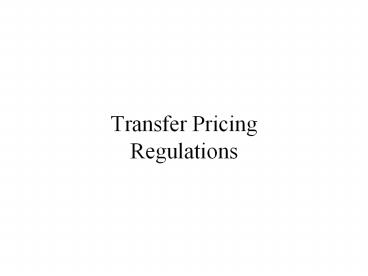Transfer Pricing Regulations - PowerPoint PPT Presentation
Title:
Transfer Pricing Regulations
Description:
Transfer Pricing Regulations Transfer Price: What and Why? TP means the value or price at which transactions take place amongst related parties. – PowerPoint PPT presentation
Number of Views:150
Avg rating:3.0/5.0
Title: Transfer Pricing Regulations
1
Transfer PricingRegulations
2
(No Transcript)
3
(No Transcript)
4
(No Transcript)
5
Transfer Price What and Why?
- TP means the value or price at which transactions
take place amongst related parties. - TP are the prices at which an enterprise
transfers physical goods and intangible property
and provides services to associated enterprises - TP gain significance because these can be used by
the controlling party to their advantage to
minimise tax incidence.
6
Transfer Price What and Why?
- Approximately 60 of the total transactions
across the world are between related parties. - If the transactions are across different tax
jurisdictions, where tax rates are different,
shifting is beneficial.
7
Factors Affecting Transfer Pricing
- Internal factors Performance Measurement and
Evaluation - External Factors
- Accounting Standard
- Income Tax
- Custom Duty
- Currency Fluctuations
- Risk of Expropriation
8
Transfer Price Regulations
- International
- OECD formulated Guidelines on transfer pricing.
They serve as generally accepted practices by the
tax authorities
- India
- The Finance Act 2001 introduced the detailed TPR
w.e.f. 1st April 2001 - The Income Tax Act
- AS-18
- Other Relevant Acts
9
Accounting Standard 18
- Requires disclosure of any elements of the
related party transactions necessary for an
understanding of the financial statements.
10
Related Parties
- Control by ownership
- 50 of the voting right
- Control over composition of board of directors
- Power to appoint or remove the directors
- Control of substantial interest
- 20 or more interest in the voting power
11
AS-18 and Transactions
- Purchase and sale of goods
- Rendering or receiving services
- Agency arrangements
- Leasing arrangements
- Transfer of research and development
- Licence aggrements
- Finance
- Guarantees and collaterals
- Management contracts.
12
Income Tax Act and TP
- Finance Act 2001 substituted the old section of
92 of the ITA by sections 92,92A to 92 F. - These sections are the backbone of Indian TPR.
- These sections define the meaning of related
parties, international transactions, pricing
methodologies etc.
13
TPR Some Important Concepts
- Income/Expenses/Cost arising from an
international transaction shall be computed
having regard to arms length price (ALP). - ALP provisions can be applied if it leads to
decrease in taxable income or increase in losses.
14
Associate Enterprise 92A
- Direct Control/Control through intermediary
- Holding 26 of voting power
- Advance of not less than 51 of the total assets
of borrowing company. - Guarantees not less than 10 on behalf of
borrower - Appointment of more than 50 of the BoD
- Dependence for 90 or more of the total raw
material or other consumables
15
International Transactions 92B
- Transaction between two or more AE of which
either both or anyone is a non-resident. - Transactions
- Purchase/Sale/Lease
- Provision of service
- Lending or borrowing
16
Arms Length Price
- Price which two independent firms would agree on.
- Price which is generally charged in a transaction
between persons other than associated
enterprises.
17
Arms Length Price 92C
- Comparable uncontrolled price method
- Resale price method
- Cost plus method
- Profit split method
18
Comparable uncontrolled price method
- CUP method compares the price transferred in a
controlled transaction to the price charged in a
comparable un-controlled transaction. - CUP method is the most direct and reliable way to
apply the arms length principle.
19
Resale price method
- The resale price method begins with the price at
which a product is resold to an independent
enterprise (IE)by an associate enterprise. - X sold to AE at Rs. 1000 (profit 300)
- AE sold to an IE at Rs. 2000
- (profit of Rs. 500 for relevant IE)
- Arms length price 2000 - 500 1500
20
Profit Split Method
- PSM is used when transactions are inter-related
and is not possible to evaluate separately. - PSM first identifies the profit to be split for
the AE. The profit so determined is split between
the AE on the basis of the functions
performed/assets/CE
21
Cost Plus Method
- In CP method, first the cost incurred is
determined. An appropriate cost plus mark-up is
then added to the cost to arrive at an
appropriate profit. The resultant figure is the
arms length price.
22
Some Transactions subject to ALP
- Purchase at little or no cost.
- Payment for services never rendered.
- Sales below MP/ Purchase above MP
- Interest free borrowings
- Exchanging property
- Selling of real estate at a price different from
MP - Use of trade names or patents at exorbitant rates
even after their expiry.
23
Some Cases
- Kinetic Honda Motors
- Collaborator Honda Motor Co. Ltd Japan and their
Subsidiary Honda Trading Corpn. Japan - Hero Honda Motors Ltd.
- Parent Honda Motor Co. Ltd Japan and their
Subsidiary Honda Trading Corpn. Japan
24
Some Cases
- Peico Electronics Electricals Ltd.
- Parent Phillips Netherlands and its subsidiaries
- Asea Brown Boveri
- Parent ABB Switzerland and its subsidiaries
- Videocon Group
- Collaborators Toshiba Co., Mitsubishi Co
25
(No Transcript)

